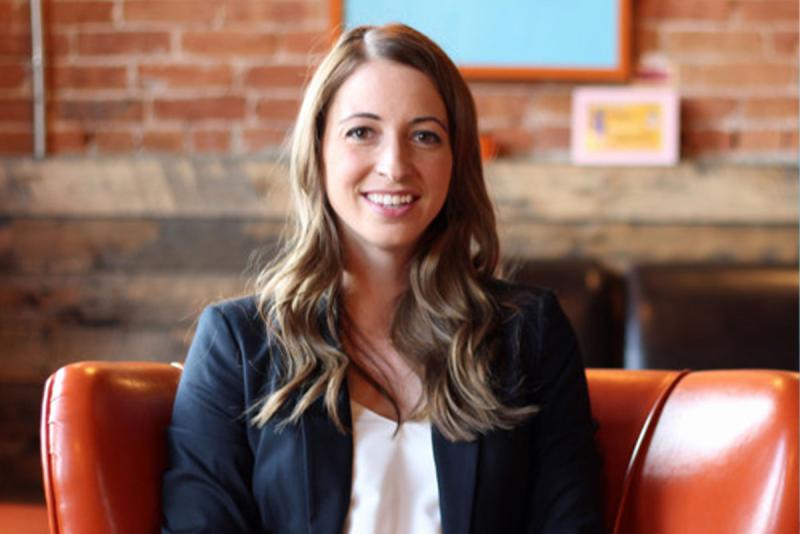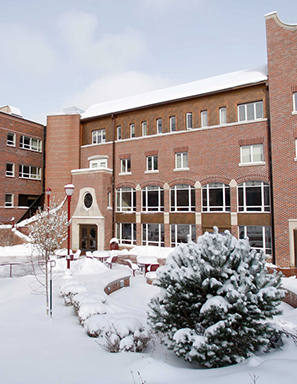Increasing Opportunities for Youth Voice & Empowerment
Recent PhD graduate Stephanie Nisle-Mikos studies student empowerment in high-poverty schools

As the first person in her family to earn a college degree, Stephanie Nisle-Mikos, PhD ’24, says she encountered “amazing teachers” throughout her education. “I wouldn’t be sitting here today with a doctorate without the influence of the teachers who saw abilities in me that I didn’t see myself. I believe in the power a teacher or a school can have in shaping a young person’s life.”
Nisle-Mikos works as a licensed school-based therapist and has focused her research on education and youth development — student empowerment and student voice, in particular. Drawing on student empowerment and deficit thinking theories, her dissertation, “Changing the Narrative: Student Empowerment in Unequal School Contexts,” examines how student–teacher relationships, shared power and decision-making between students and staff, and a sense of community can facilitate feelings of empowerment for students in high-poverty schools.
According to Nisle-Mikos, “High-poverty schools make up one third of all public schools in the United States. Within these schools, student success is mainly measured by test scores or graduation rates when in reality, things like funding differences, opportunity gaps and quality of educators create differences in outcomes for students.” She further elaborates that deficit thinking places the onus for student failure on the individual rather than the system, thus blaming internal deficits on students rather than acknowledging the systemic barriers to learning and student success. “Empowerment is the opposite side of the coin — a possible solution to the problem. Empowerment highlights student strengths, uses teachers as collaborators rather than experts in positions of power and helps adults to see solutions.”
Nisle-Mikos says youth empowerment is important because young people don’t have much control over their lives and are often told what to do, how to do it and when to do it. “By continuing to minimize students’ perspectives, we’re missing their voices, and they’re the real experts. They’re the ones going through the experience. Often, adults are speaking for them, but that’s not always the best thing for the students. As adults, we may be too removed from the problem. Young people bring a new perspective.”
Nisle-Mikos notes that students of color and dual-language learners are overrepresented in high-poverty schools, where student voice and student empowerment tend to be low and can ultimately affect student success. She contends, “The life trajectories of students who attend high-poverty schools are not the same as youth who attend schools with greater resources.” Nisle-Mikos adds that empowerment is even more important in the context of high-poverty schools. “A lot of times in marginalized communities, [youth] voices are missing from important conversations,” including conversations about learning.
Nisle-Mikos’s dissertation research focused on one elementary school classified as high poverty, where she surveyed 109 students in grades 4 to 6 and completed individual interviews with 22 of those students. She found that students in lower grades tended to feel more empowered, but empowerment waned as students aged. Nisle-Mikos provides one possible explanation: The quality of students’ relationships with teachers tend to decline as students age, particularly in school environments with high levels of poverty. In addition, according to the literature, as students age they crave more independence and might begin recognizing different character traits in their teachers.
Nisle-Mikos also found that male students reported feeling less empowered than female students — possibly because girls tend to build more care-centered relationships and have greater personal connection to teachers (more of whom are female), according to existing research. In Nisle-Mikos’s survey, students of color reported lower perceptions of empowerment, whereas students of color who participated in the interviews reported higher rates of perceived empowerment — a difference that will require additional research to fully explain.
This fall, Nisle-Mikos will share her findings and their implications in a professional development presentation at the school where she conducted her research. Generally, she says, schools need to facilitate more opportunities — especially in higher grades — for student independence, voice and choice while nurturing strong relationships between teachers and their students. Approaches that have been shown to work include offering choices in the classroom (for example, test-taking modalities and the order in which students complete tasks), holding classroom meetings to share decision-making, modeling respect and asking for student input on disciplinary practices.
Because students in her study shared that bullying and inappropriate language reduced their feelings of empowerment, Nisle-Mikos also recommends attending to student–student dynamics.
“Students wanted teachers who took a genuine interest in them — who were curious as to who they are as cultural beings. They also wanted their teachers to be human beings,” says Nisle-Mikos, noting that one way to achieve this is for school staff (not just teachers) to acknowledge students by name. “The more connections students have to adults in the building, the more sense of community they have.”
These may seem like common-sense approaches, but according to Nisle-Mikos, systemic issues often impede implementation. For example, she says, the Every Student Succeeds Act is focused on performance-based tests, so when teachers are preparing students for tests, they might resist changes unless they see them as a strategy to improve test scores.
Nisle-Mikos argues that working collaboratively with students rather than in a position of power is a cost-efficient, low-stakes intervention “that will better serve students in the long run.”
Ultimately, Nisle-Mikos believes that when students feel more empowered in school, they are more likely to succeed. “When we create safe, welcoming communities where students can share their voices and take risks, we’re going to see better academic outcomes and increased well-being of young people.”




